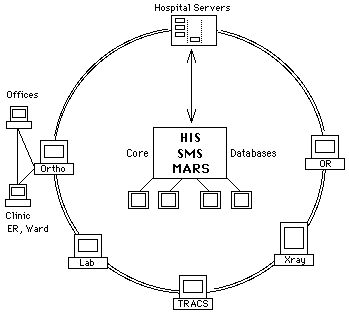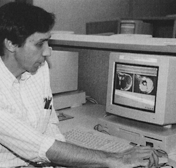 |
Diagram of Trauma Register Network at Vanderbilt |
From Orthopaedia Vol 13, No 1, Spring 1998 - News from the Department of Orthopaedics and Rehabilitation Vanderbilt University School of Medicine - by Holly Quick.
"From the patient's bedside to the upper echelons of the Department of Health and Human Services, data with which to make informed decisions is lacking." Dr. Richard S. Dick, former head of the Computerized Medical Record Institute of the National Academy of Sciences Institute of Medicine.
"It has become increasingly clear that much of the clinical research that has long been published and on which we base much of our education and practice activity is, in fact, severely flawed." Dr. Robert Keller, former chair of the AAOS Committee on Outcomes in Spine, 1995.
How can physicians acquire the data necessary to make informed decisions about patient care -- to determine what medical care is indicated, what it costs, and what are the real outcomes? The Trauma Register at Vanderbilt Orthopaedics was born out of a desire to answer these questions.
The Trauma Register is the brainchild of William Burman, MD, former Assistant Professor of Orthopaedics at the State University of New York in Brooklyn and Chief of Orthopaedics at Kings County Hospital in Brooklyn. Introduced at Vanderbilt by Kenneth D. Johnson, MD, Professor of Orthopaedics, the Trauma Register is a computer database system which captures and stores the observations of injury and disease severity by the most seasoned observers available, the physicians responsible for the care of patients. Because doctors themselves enter data, the database is lent greater accuracy. The Trauma Register's aim is to obtain highly specific and uniform data in numbers of statistical significance.
 |
Diagram of Trauma Register Network at Vanderbilt |
In addition to the input of physicians, the system also taps into other valuable hospital information resources in order to complete a complex picture of a patient's care. With the assistance of VUMC networking and the orthopaedic department LAN manager John Outlan, links have been created to the TRACS data base of the department of trauma surgery with the help of Dr. John Morris, Kelly Collins, and John Bass; to the hospital SMS Vcare information system through the offices of Johniene Doran; to the implant data of the operating room database with the help of Mark Atkins and Ron Beamon; to the WIZ order system of Dr. Antoine Giessbuhler; and to the MARS (Medical Archiving Record System - the VUMC electronic patient record) of Dr. Dario Giuse. Further links for lab data, billing, and objective and subjective outcome data are planned. Ultimately, Dr. Burman seeks to connect with every source possible that impacts on care and result of care of patients within the hospital.
Inaugurated by the Orthopaedic Trauma Section, the program has recently been expanded within the department to include Pediatric Orthopaedics, Hand Surgery, and Spine Surgery.
The exchange of data serves to avoid duplicate entry and lighten the individual input load, which if excessive, leads to a fatigue failure of the system. It also permits cross validation of the data entry in such a way that it is critically read by peers and individuals in other disciplines locally before it is published nationally. Dr. Burman believes that "only through such a mechanism, which is quite similar to that used for the provision of care, can we derive a reasonable instrument for measuring the quality and cost of that care."
Guillot et al opined in the Journal of Trauma, "Maintenance of an active registry must be viewed as important as the medical care rendered, if the right person is going to receive the right treatment in a timely fashion without undue cost to society." However, less than 1% of what is spent on medical care goes toward assessing the effectiveness of that care. "Since the time of EA Codman, considered by many to be the father of modern orthopaedic surgery with the introduction of x rays, new concepts in shoulder surgery and musculoskeletal pathology, the pursuit of end-result analysis has always been precarious," says Dr. Burman. "This reluctance over time to face up to the laborious and possibly humiliating measurement of outcome is definitely a factor in today's crisis of medical management. Assisted as we are now by a vast array of computing and telecommunications options with which to shatter barriers of time, information, and distance, circumventing the ageless political nemesis of A.E. Codman remains the formidable challenge."
This pioneering effort spearheaded by the Department of Orthopaedics at Vanderbilt is a rare collaboration within and beyond VUMC. Since it was first implemented at Vanderbilt, the Trauma Register network has expanded to include Wayne State School of Medicine in Detroit, the Department of Orthopaedics at Mt. Sinai School of Medicine in Elmhurst, Queens, New York, Rhode Island Hospital at Brown University, and Hennepin County Medical Center at the University of Minnesota at Minneapolis. Newer links to the network are currently being forged at Denver General Hospital at the University of Colorado School of Medicine and Maricopa Hospital at the University of Arizona in Phoenix.
 |
Dr. William Burman studies images |
Dr. Burman envisions this network linking hospitals across the country, and, eventually, around the world, enabling physicians to compare treatment and outcomes between centers and in different countries, and so to ascertain the impact of different systems of medical care. Dr. Burman, through his HWB Foundation (Hippocrates - Winslow - Babbage), offers hospitals help in the form of software and equipment support. What he wants in return is a copy of the data to combine with data already in place. The contents of the Register are published at the HWB Foundation Website.
The Register is of pragmatic benefit to the department as well, because it provides a means of comparing Vanderbilt Orthopaedics' performance, its treatments and outcomes, with that of other local hospitals and private practices. Since Vanderbilt Orthopaedics sees much more difficult cases than other practices in the area, risk adjustment is important. The comprehensive and accurate data provided by the Register makes that possible.
Managed care asks, "What are we buying from this group?" Information derived from the Register will enable the department to answer this question, and to enter contract negotiations with purchasers of medical care knowing its strengths and weaknesses. The Register promises standard evaluation, better documentation, and lower medical-legal risk for physicians.
The data needed to make informed treatment decisions are there, they only need to be organized. Meaningful and accurate data are required for provision of good, cost-effective care, as well as for substantive, valid scientific research. It is Drs. Burman's belief that the Trauma Register will bring greater reason to the discussion of health care, and careful observation to the science of medicine. To make sense of the puzzle of orthopaedic trauma and disease, many pieces must be put together. With the Trauma Register, finding those pieces and fitting them into a comprehensive whole is now easier.
ORTHOPAEDIC TRAUMA ASSOCIATION
Date: Mar 31, 2000
An Official Endorsement of the HyperCard based Trauma Register Program by the Orthopaedic Trauma Association
In recognition of sustained effort over a decade to improve the quality of core data used for orthopaedic trauma teaching and practice, The Orthopaedic Trauma Association hereby confers upon the Apple Macintosh Hypercard program, the Trauma Register, official status as an OTA instrument which is dedicated to the measurement of the efficacy of orthopaedic trauma care.
Its innovative use of networked hospital information resources, knowledge-coupling of data collection with "just-in-time" education, direct physician structured data entry input, medical alerts against potential complications, seamless integration of multiple image processing, mapping, web browsing, database, e-mail, text processing and scheduling applications has led to its deployment in 14 major North American and European trauma centers for a compilation of over 27,000 records despite an absence of any specific grant funding, local technical support and often, outright resistance of many networking and information technology services to the Macintosh operating system as required by the core Hypercard application.
While the work of EMR (electronic medical record) and of Outcome End Result Analysis (the final arbiter of the quality and cost of medical services rendered) remains incomplete, the Trauma Register Program continues to probe at the cutting edge of medical informatics in order to determine what works and what doesn't in the capture of a complete and accurate portrayal of the care of the injured patient.
In the Journal of Trauma 29:1667, 1989, Gillot et al, have stated:
"Maintenance of an active registry must be viewed as important as the medical care rendered, if the right person is going to receive the right treatment in a timely fashion without undue cost to society."
Consistent with this premise, the Trauma Register Program rates the official endorsement of the Orthopaedic Trauma Association.
The Orthopaedic Trauma Association is devoted to encouraging research and disseminating knowledge about musculoskeletal injuries. It organizes multi-center research projects, provides a national forum for scientific papers related to orthopaedic trauma management, conducts educational courses and workshops, and represents orthopaedic traumatology in the Council of Musculoskeletal Specialty Societies of the American Academy of Orthopaedic Surgeons.